
| HOME | BOOKS | ABOUT US | CONTACT US | ARTICLES | CLIENT LIST | LINKS |
Articles on EATiQuette have run in many Phoenix-area and national publications. EATiQuette was featured on WealthTV's (AWE) "Etiquette 101" episode on dining etiquette. David has appeared on KSAZ-FOX10's Arizona Morning, KPNX-NBC 12 and KPHO-CBS 5 evening newscasts, on KXAM-1310's Club Cucina, Radio Cafe and Culinary Confessions, KTKT Tucson's Dinner Hour with Alan Zeman and Richard Tyler, CKNX's Talk Radio with Bryan Allen in Ontario, Canada and on Wisconsin Public Radio's Tom Clark Show. Besides the articles shown below, our book, The Main Course on Table Service, has been featured in articles in the San Francisco Examiner, Ocala (FL) Star-Banner, The Cleveland Plaindealer and Arizona Trends. The San Jose (CA) Mercury News ran an item on our EATiQuette website and services in both its Food and Technology sections. David's etiquette training for high school students has also been featured in Education Weekly and the editorial page of the Chicago Tribune.
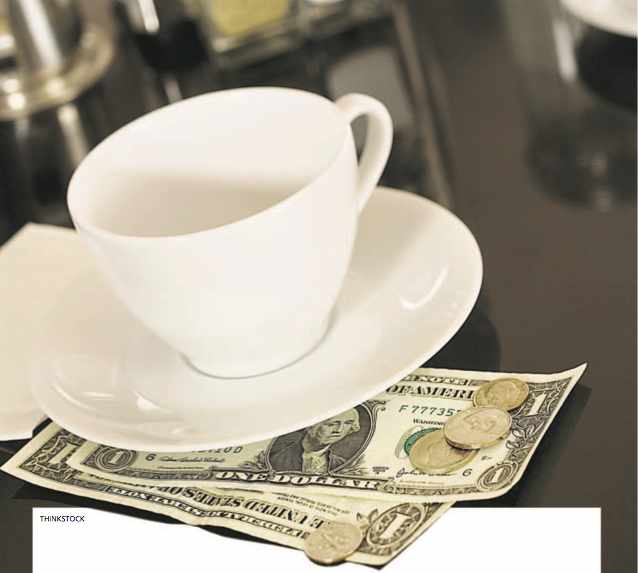
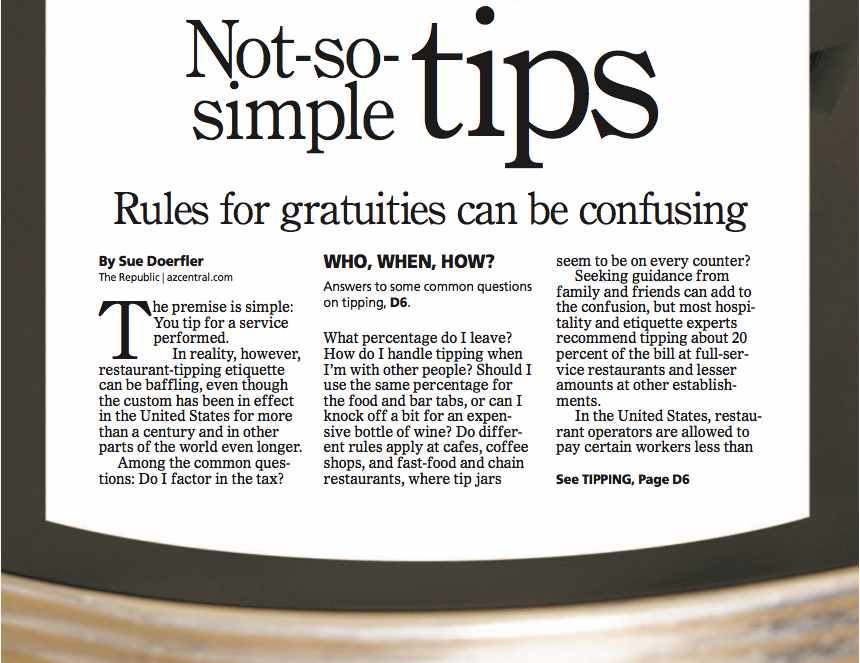
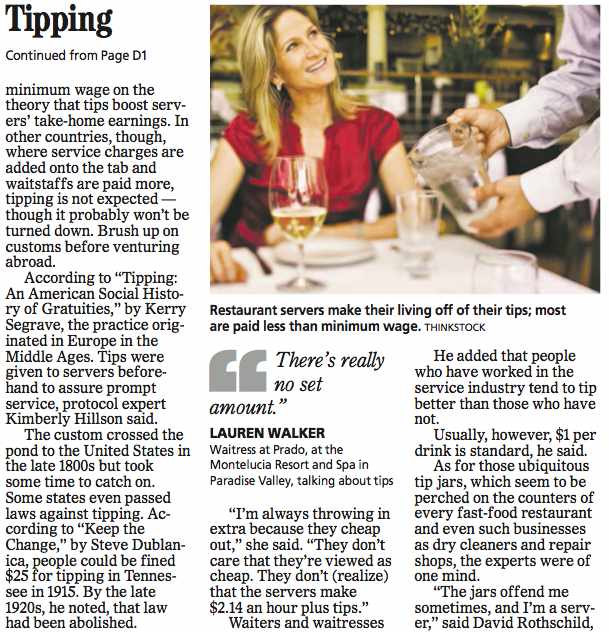
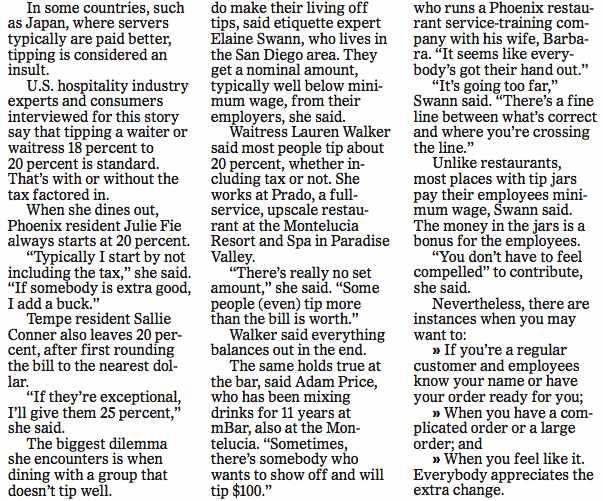
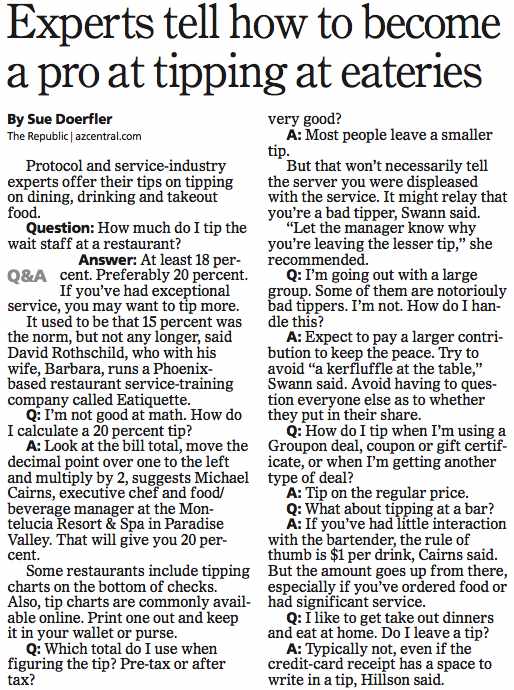
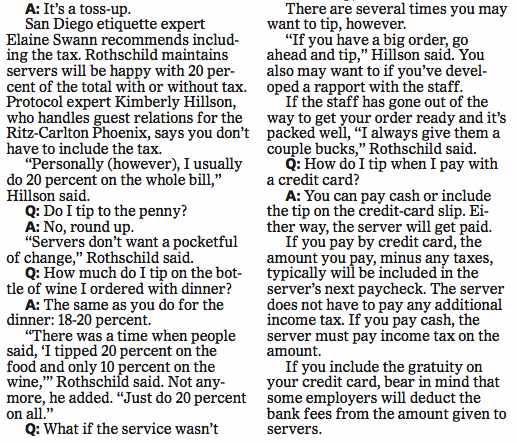

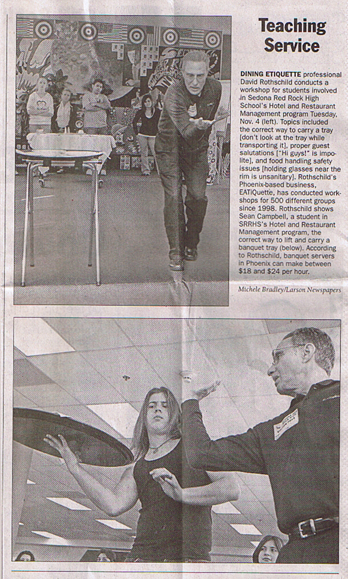
East Valley/Scottsdale Tribune's |
Tips on tipping
By ADRIENNE FRANK
Here’s a tip: Don’t be stingy with the gratuity next time you dine out.
According to David Rothschild, director of the culinary arts program at MetroTech High School in Phoenix, while 15 percent is still the standard, many diners are becoming more generous with the tip.
“There’s really no consensus, but I think people are starting to tip somewhere between 17 and 18 percent. A really generous tipper will leave 20 percent.”
Rothschild, who, along with wife Barbara, owns EATiQuette, a Phoenix- based company that hosts workshops for servers and etiquette classes for diners, says there are several factors folks should consider when determining the tip.
“Tipping is supposed to ensure prompt service, so if your server attends to you promptly and with a smile, he or she should be rewarded. Product knowledge is important, as are the server’s communication skills.
“Ultimately, you should get the feeling that a server really cares whether or not you had a good dining experience.”
Rothschild says it’s also important to remember that most servers only make $2.17 per hour and thus, “they really work for tips.”
Rothschild weighed in on the following 10 dining scenarios, offering these helpful tipping hints:
Scenario No. 1: The service is poor and your server is a jerk
“Tipping is obviously not mandatory — it’s always up to the discretion of the guest. And there are times when not leaving a tip sends a message. If I received horrible service, I might write a note on the guest check saying, ‘I don’t think you deserve a tip and this is why.’ ”
Scenario No. 2: The service is poor but the server is friendly and seems well-intentioned
“Well, ‘A’ for effort. But I still might go toward the lower end of the tip scale.”
Scenario No. 3: You’re dining at a buffet-style restaurant like Souper Salad and the server is only responsible for clearing your plates and refilling your drink
“It’s strange — people will tip very generously at hotel brunches, but if they go to a Souper Salad, they won’t leave anything. A general rule of thumb is 10 percent of the bill, or $1 or $2.”
Scenario No. 4: The tab at your favorite breakfast spot only comes to $10
“I think the hardest meal of the day for a server is breakfast, because people need their coffee right away. They’ll say, ‘Don’t talk to me until I get my coffee.’ But, prices are less at breakfast. In those situations, it’s OK to tip 20 or even 30 percent — because on a $10 bill, that’s only going to be $2 or $3.”
Scenario No. 5: You place your order at the counter and someone delivers your food to the table
“That’s up to guest’s discretion. You could leave $1 or $2, but it’s certainly not required or expected.”
Scenario No. 6: You pick up a to-go order at a sit-down restaurant
“If you’ve got a large to-go order it would be a nice gesture to leave a couple dollars. If you have 10 or 15 orders going to the same office building, you’re taking up a good deal of their time. I’m certain a tip would be appreciated.”
Scenario No. 7: You have a coupon for a free entree with the purchase of another entree
“Always tip on what the price would have been before the discount.”
Scenario No. 8: The server adds his own tip to the bill
“One of my pet peeves in restaurants is unscrupulous servers who add their tip into the bill. Then, if you don’t check it carefully, you’ll write in a second tip. So make sure you double check your bill.”
Scenario No. 9: The food is slow coming out of the kitchen
“Don’t penalize the server; he has no control over what’s going on in the kitchen.”
Scenario No. 10: You order a pizza to be delivered
“I actually had to consult one of my students on this, because I had no idea. If you order one pizza, the standard tip is $1; additional pizzas are 50 cents.”
When it comes to dining etiquette, mind your manners
By CHRISTINA MINOR / Cox News Service
WACO, Texas -- You hear the dreaded call from the waiter, "Dinner is served."
While certain settings call for the remembrance of certain etiquette rules, such as a seven-course dinner vs. a meal at home, the basic table manners don't change from place to place.
Chewing with the mouth open, shoveling in food and talking with the mouth full are basic no-nos. Grossing out your dinner partner is not what you want to do, Post said.
Other basic rules include never putting elbows on the table or leaning over the table to eat. All diners should be sitting a hands-length from the table. And never chew gum, pick your teeth or apply lipstick at the table.
Table conversations should exclude taboo topics, including politics, sex and religion -- anything that will give you heartburn, said Rothschild, who also wrote "The Main Course of Table Service".
Etiquette trainers say these basic procedures are not being passed on to children, which means table manners are getting worse.
Post said it's important for parents to sit down with their children and demonstrate appropriate eating behavior.
"If they see you slurping this and smacking that, then they're going to do it," Post said. "We don't teach kids anymore. We live in such a fast-paced society. It's rush, rush, rush. You always hear, 'How are we going to teach kids?' We teach them by showing them."
As soon as children can eat with an utensil, they should start learning good table manners, Rothschild said.
"Table manners are a great equalizer," Rothschild said. "You can sit at the table with the rich and famous and don't have to be either. Plus a lot of business meetings and interviews are conducted at the table. You want to be able to show people that you have good manners."
Christina Minor writes for the Waco Tribune-Herald
Here are a few rules to follow if you find yourself at a fancy dinner and don't know what's what.
|
|
Check (List), Please Good service can rescue a bad meal, industry insiders will tell you, but nothing makes up for bad service. That's why the bulk of restaurant complaints boil down to poor treatment at the hands of thoughtless staff. Clevelanders, of course, aren't the only people who struggle with indifferent, rude, or downright hostile waiters and waitresses. The lack of professional servers is a problem nationwide, and it spurred Phoenix restaurateur and culinary instructor David Rothschild to write The Main Course on Table Service: Skills & Tips for Becoming a Confident, Efficient, Professional Server. The slender volume ($19.95, available at www.EATiQuette.com) is not only a good training resource, but it also offers diners an objective look at what constitutes proper service. Here are some pointers for servers: Do . . . Don't . . .
By Barbara Yost Some of David Rothschild's best friends are waiters. The native New Yorker started waiting tables 30 years ago in the Catskills when he was just 15. He put himself through college as a server. In the Valley, he has worked at such high-end dining rooms as the Arizona Biltmore, the old Registry Resort's La Champagne and A Different Pointe of View. He has worked for fabled chefs Vincent Guerithault and Razz Kamnitzer. For 14 years, he has taught courses in food service at Metro Tech, a Phoenix vocational high school. He's co-owner of the EATiQuette dining etiquette seminars. Those credentials and a bout of illness this past summer inspired Rothschild to put his wisdom into a book, The Main Course on Table Service, a primer for beginning servers and, Rothschild promises, a good read for consumers who like anecdotes about the restaurant industry. Servers who have read the book have been "reinvigorated," he says, by its message of respect for a job that in Europe is considered a worthy career, and all too often in America is considered a day job that supports real careers, such as acting. Phoenix has grown considerably in its dining sophistication, Rothschild says, today enjoying a core of servers who consider themselves professionals. For the novice server and even for professionals wanting a refresher course, The Main Course serves up chapters on the politics of the kitchen hierarchy, the "whys" of how meals are served, traditional food courses, and cocktail and wine service. The most common complaints from servers: diners who have unreasonable expectations of service in low-end restaurants, and consumers who experiment with unfamiliar foods and then turn up their noses when the food isn't what they expected, no matter how expertly prepared. Customers most often complain about servers who neglect or rush them. Rothschild's best advice to consumers who want a satisfying dining experience is to avoid eating out on Saturday. "Amateur night," he says. Best service in town? Vincent's on Camelback, Different Pointe of View, the Marquesa at the Fairmont Scottsdale Princess, Four Seasons, and most restaurants in Tucson, a cut above the Valley. Rothschild's book is available at his Web site, www.eatiquette.com.
Both the owners and employees of Tiramisu (see review above) could use a copy of The Main Course on Table Service, the new book by veteran server David Rothschild, who co-owns the Phoenix-based EATiQuette waitstaff-training and dining-etiquette company. In fact, at $19.95 a copy, The Main Course wouldn't be a bad investment for any restaurant looking to inject a bit of old-fashioned service sense into its staff. For anyone who eats out, the book is a reminder of what suitable service used to be. Remember when waitrons knew to serve from the left and clear from the right, or to move around a table when taking orders instead of standing in one spot? The book isn't just for fine-dining establishments, either; it includes some especially good points about booth service, such as the benefits of adhering to a seat-designation system so there's some semblance of organization when the plates arrive. Rothschild has a pretty straightforward, gosh-shucks writing style, which made the book a bit dry (I kept wanting him to say wicked things like Anthony Bourdain did in KitchenConfidential). Still, he offers useful tips that I'd forgotten from my serving/bartending days in college, as well as one I'd remembered that's applicable in everyday life: how to keep soup (or anything, really) from splashing. As once explained to me by a chef (who may have gotten it from Marilyn vos Savant, as Rothschild says he did), "When you walk, you keep your balance smooth by orienting to your surroundings. If, instead, you orient to a bowl of soup you're carrying, you're orienting to a moving target...yourself." Try it -- it works. The tips (no pun intended) that eateries in this town could definitely use: taking reservations using a voice that sounds like the restaurant is happy to have people eat there; acknowledging diners within thirty seconds of their walking through the door (instead of making them stand there as though you're doing them a favor by letting them in the place); bussing tables throughout the meal (no straw wrappers or other detritus should be allowed to build up, even in the lowliest truck stop); and keeping track of who orders what (the restaurant itself should set the system) so that there isn't an "auction" when the food arrives (as in, "Who gets the hamburger?"). As someone who eats out more than most people, I'd have to say that the transgression committed all too often in this town involves servers who don't know how to "read" a table correctly to avoid long waits between courses. According to Rothschild, appetizers should appear no later than ten minutes after the order is placed, with entrees and desserts coming no more than ten minutes after the previous course has been cleared. Ha! I can't remember the last time a restaurant hit this mark. Granted, longer waits are sometimes welcome, such as when a couple is obviously celebrating an anniversary and ordering a bottle of wine with every course -- but that's where reading a table comes in. The way most servers have read my table would indicate that they thought I planned to set up a TV and take a nap sometime during the meal. Rothschild has another pet peeve: servers who think it's hilarious to ask a diner about the meal when he or she has a mouth full of food. "In private, servers will admit to doing this as a way to amuse themselves," he writes. "Guests rarely find it so funny." Amen, brother. I couldn't find The Main Course locally, but it's available through the company's Web site at EATiQuette.com (the e-book is $15.95) or by calling 602-569-2051. Hey, it can't hurt. As the economy tries to straighten itself out and restaurants fight to stay in business, maybe 2002 will finally be the year of the server.
From the minute patrons enter a restaurant, most managers and servers work hard to please them. But not everyone can be satisfied. When it comes to complaining about service, there's a right way and wrong way to go about it, experts say. David Cyrelson, author of Great Tips: The Ultimate How To Manual for Waiters and Waitresses , said a good rule of thumb is if you want respect as a customer then treat the server likewise. "It's always OK to complain," he said. "But remember, just because you don't like the way the meal tasted doesn't mean it's the server's fault." Cyrelson, who also is a motivational speaker, said think of complaining as offering constructive criticism. Don't immediately start with whiny remarks or things that are out of the server's control. A baby crying at the table next to yours or a large, noisy group are not a part of your server's responsibility. David Rothschild, author of The Main Course on Table Service , said patrons should "call (mistakes) to the attention of the server" instead of complaining. "There's a polite, constructive way of doing this," he said. "And then there's the negative approach. Guests should always keep in mind that it's not always the server's fault that the meal didn't meet their expectations." Rothschild, who also is owner and presenter of EATiQuette wait-staff training and dining etiquette seminars, recommends the dissatisfied customer step away from the table and speak calmly and rationally to the server about the problem. Give the server a chance to rectify the situation. If you are still displeased, then talk with the manager. If all else fails, write a letter to the restaurant's owner or cross that food establishment off your list. Rothschild said waiters and waitresses should be trained in five things when dealing with unhappy guests: listening, empathize, prioritizing options, coming up with a solution and acting. Cyrelson said a server has to take on three roles in order to be successful. "Being a waiter or waitress is harder than most people think," he said. "They have to have the managing skills of an air-traffic controller; the entertaining skills of a Broadway actor; and the diplomatic skills of an ambassador. Doing each one separately is difficult, but it's very tough when you put them together." Most customers really don't want to complain, especially if the incident is minor, Cyrelson said. Customers also don't want to stiff the server or, lastly, get a waiter fired, he said. "But customers also want things done right," Cyrelson said. Cyrelson said if customers have a valid complaint, such as they found something in their food, then tell the server immediately. The last thing a manager wants is an unhappy patron leaving the restaurant, he said. "If the customer is not satisfied then they are going to go tell others about the poor service," he said. "Aggravated customers can be expensive. If an owner is going to invest in a restaurant, they want to keep it going. Every time they have a customer come in, the server is the single greatest way to get the customer excited about the place. And if that customer is excited, then he is going to be a walking advertisement." Rothschild said an unhappy patron "is likely to share his displeasure with an average of 11 other people," so most restaurants will bend over backward to be sure that patrons are happy with their experiences. "The saying, ‘the customer is always right’ is still generally the norm in the industry," he said. And when it comes to dining out, customers also expect great service and a friendly server, but they need to remember the situation. "Don't expect fine dining service at a diner," Rothschild said. "And remember that the level of service for a $5 meal is going to be different than that of a $50 meal. But the guest has every right to expect a smile, that his order be correctly taken and delivered correctly and that the check be presented promptly and for the correct amount, regardless of the environment." Constructive complaining tips David Rothschild and David Cyrelson make the following suggestions to help customers have a pleasant dining experience: • Match the restaurant to the occasion. "If you have to be at a movie in 20 minutes, then don't choose a place where you know it's going to take an hour to eat," Cyrelson said. • Read the menu carefully before making your selection. Most have descriptions of food, which saves both you and the server the time and trouble of repeating the menu. And don't create your own dish, Cyrelson said. •: This is one of my biggest pet peeves," he said. "If the menu has Hawaiian chicken and shrimp scampi listed, don't ask for Hawaiian shrimp. Sure the chef has the ingredients, but that's not what he is making." • Let the server know the food is bad after the first bite or two. Don't eat the entire meal then expect to have your money refunded or not to have to pay for it, Rothschild said. • Don't send several servers on one errand. If the first server hasn't returned with the teaspoon you asked for 20 minutes ago, then ask another. But have some patience, Cyrelson said. • If the server says he can't change a dish to fit your liking, it's probably because the kitchen can only prepare it one way. Try ordering something else. If you have specific dietary restrictions or preferences, find a restaurant that is more willing to work with you. Some restaurants are more accommodating than others, Rothschild said. • Let the server know about bill changes before ordering. If separate checks are needed, or you have a coupon, inform the server first. That way there won't be any confusion at the end of the meal, Cyrelson said. • And, of course, the big question: tipping. According to Rothschild, tipping is not mandatory, so you don't have to leave a tip. If the server is rude, it's OK to use your tip as a way to express your dissatisfaction, but it's probably more productive to explain why you left the smaller tip. "A tip is a thank-you for service, but also keep in mind that it's, more often than not, a major part of the server's livelihood," Rothschild said.
by Janie Magruder . . . David Rothschild is picking up the ball that parents have dropped by offering classes on table manners for young people, fifth grade through college. "I ask them, 'How many of you sit down at the table with your families and have dinner on a regular basis?'" says Rothschild, a Metro Tech High teacher and owner of EATiQuette. "With most groups, it's 10 percent." He reached about 900 students last year...imparting tips on handling silverware, going through a buffet line and seating arrangements. "I tell the kids, 'You're going to have (job) interviews and some will be over lunch, and that's where some of the first judgments of you are made," Rothschild says. "If you start out on the wrong foot, you're not going to get the job."
Share and share a lot -- but know the rules "Chow Lines" by Barbara Yost Tim Zagat, publisher of the Zagat restaurant guidebooks, has a marvelous toy: It's a telescoping fork that extends to 3 feet so he can easily spear the food off a companion's plate and sample wares far away from his own. However, if you're of the mind that sharing offers an opportunity to sample a variety of foods beyond your own plate, you will think of such a utensil as a magic wand bestowed by the Good Fairy of Foodland. I love sharing, although I'm peeved when a dining companion begs off dessert, then launches into mine using a spoon like a Scud missile. When agreed upon, however, sharing opens up new worlds. If a menu offers too many choices, the only answer is to order the best and split them. A recent New York Times article took umbrage at the notion of sharing, crowning none other than Julia Child as the queen of the anti-communal meal trend. Her majesty has gone so far as to demand everyone at her table order the same thing so that they won't be tempted to snag a taste of hers. Why such a food maven as Julia Child would ask everyone to eat in lockstep is a puzzle. In my dreams, I'm eating at a restaurant where every item is labeled "sampler platter" and no one is forced to make choices. A minibuffet is brought to the table. Phoenix chef Michael De Maria brings that concept to his Bistro America,where patrons can share communal appetizers, soups and salads. Life is too short to eat just one appetizer or choose the tomato basil soup over the French onion. However, even those amenable to sharing must follow some guidelines, the most important of which is to ask before you reach. One's food is sacrosanct. You don't take food; you are given food. David Rothschild, president of EATiQuette, a Valley company that conducts etiquette seminars and restaurant service training and runs the Web site eatiquette.com, sees food sharing as a positive experience. "The beauty of it is you get to try more things," he says. It's that simple. Rothschild has witnessed sharing from both sides. He and his wife, Barbara, engage in consensual sampling whenever they dine out. He worked in the restaurant business for decades before forming his own company -- at such landmarks as Vincent's on Camelback, Etienne, the Arizona Biltmore's Gold Room and several of Razz Kamnitzer's restaurants. Chef Vincent Guerithault, renowned for encouraging sharing and plate splitting, is happy to oblige customers who want to spread their culinary wings. Many upscale restaurants will split dishes in the kitchen, Rothschild says, so that chefs can ensure an attractive presntation rather than leaving it to the server to hack up the chicken at the table. Some people, such as Child, consider sampling gauche and live by the rule of neither a borrower nor a lender be. In Europe, sharing just isn't done, while in Asian cultures the community table is a way of life. In fact, many Asian meals are served on a Lazy Susan that diners spin like a tantalizing wheel of fortune. "People's eating habits are so personal," Rothschild says. Some people are territorial about their plates, adopting a strict "don't ask, don't offer" policy. Fortunately, I believe, those keep-your-hands-to-yourself people are rare. That doesn't mean dining out must be a free-for-all. If you count yourself in the camp of diners who can't bear to let someone's pecan-encrusted salmon go untried, keep in mind the ground rules. Each diner should be allowed to try his or her own food first before relinquishing a taste. Ask before stabbing. To encourage sharing, try something coy such as, "My Arctic char is superb. Would you like to try some?" Hope for reciprocation. Don't hand your fork to your companion and ask to have it loaded. Some etiquette books recommend this, but Rothschild warns of the danger that food will be dropped all over the table. And don't simply plunge your utensil into your neighbor's pasta. Instead, exchange butter plates and trade samples. Many restaurants don't mind supplying extra small plates, although some charge a splitting fee if you share an entree. If you are invited to spear your own bite, don't take the best part -- the tenderloin of the T-bone, the strawberry off the top of the cheesecake, all the crunchy crust of the creme brulee. However, if you're the one preparing the sample, include a bit of sauce and some companion items (veggies, risotto) to make a proper nibble. If you are recovering from something contagious, that is the time to allow your companions to dip into your food before you do. You also must not dip into theirs if you've already put your utensils in your mouth. No double dipping. If you're sharing nachos, it's a food felony to dip a chip in the cheese, bite off the cheesy part and then dip again. Best plan is to put a dab of dip on your plate. Party hosts take note: Supply spoons for all dips and sauces. When selecting rolls and other items from communal supplies, don't paw each one looking for the rye or the sourdough. Touch only what you plan to eat. Sharing food is like taking a cruise around the world. As you travel the table, you pick up new tastes and new experiences -- the calamari you've never tried before, the mussels you never knew could be so succulent. Don't stay at home with your own plate your only port of call. Use your passport.
FRONT PAGE OF THE SCOTTSDALE (AZ) TRIBUNE: Class cooks up lessons on art of fine dining While teaching dining and resort services at MetroTech, restaurateur David Rothschild noticed how uncomfortable his students were with the idea of eating at an upscale restaurant. |
| We welcome your inquiries about our training services and publications. Please contact Barbara or David Rothschild at: 602.569.2051 or e-mail |